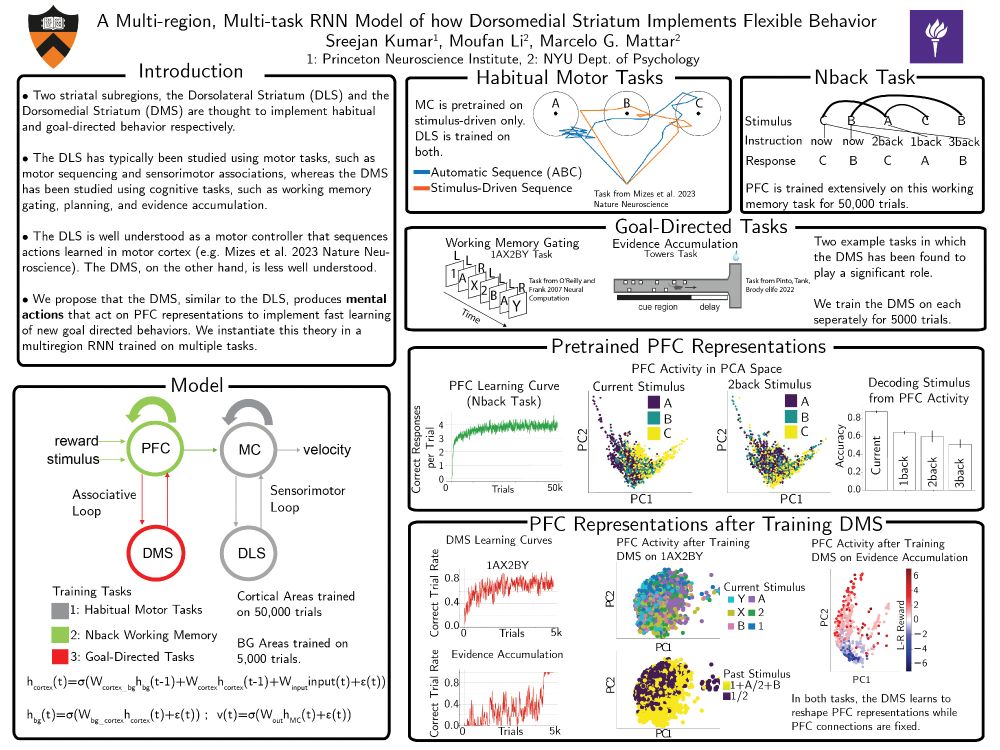Sreejan Kumar
@sreejan.bsky.social
Joint postdoc at Columbia/NYU. Sponsored by New York Academy of Sciences through Leon Levy Foundation. PhD from Princeton University, Yale '19
Second, it's known that we build compressed abstractions of our environments that allow us to generalize. What's maybe not known is that this process is intrinsically tied to forming habits and complex action plans!

September 6, 2025 at 2:36 PM
Second, it's known that we build compressed abstractions of our environments that allow us to generalize. What's maybe not known is that this process is intrinsically tied to forming habits and complex action plans!
What are the implications? First, sensory compression is not just in DLS. It's also in other areas such as Hippocampus and Cerebellum. So we predict that wherever there is sensory compression happening, there is also time encoding and support of time-sensitive behaviors.


September 6, 2025 at 2:36 PM
What are the implications? First, sensory compression is not just in DLS. It's also in other areas such as Hippocampus and Cerebellum. So we predict that wherever there is sensory compression happening, there is also time encoding and support of time-sensitive behaviors.
Second, it accounts for another result that shows something contradictory: the DLS actively uses sensory stimuli to time and execute motor habits.

September 6, 2025 at 2:36 PM
Second, it accounts for another result that shows something contradictory: the DLS actively uses sensory stimuli to time and execute motor habits.
We then show that this model accounts for seemingly paradoxical findings in time representations in the DLS. First, we show our model explains results that encoding of time in rat DLS is invariant to task relevancy and stimulus properties.

September 6, 2025 at 2:36 PM
We then show that this model accounts for seemingly paradoxical findings in time representations in the DLS. First, we show our model explains results that encoding of time in rat DLS is invariant to task relevancy and stimulus properties.
We then see that bottleneck models engage these stable neural trajectories that implicitly encode time by where you are in the trajectory.

September 6, 2025 at 2:36 PM
We then see that bottleneck models engage these stable neural trajectories that implicitly encode time by where you are in the trajectory.
We show that a model with a sensory bottleneck accounts for many behavioral effects that @gershbrain.bsky.social
and @lucylai.bsky.social
characterize in their work on human action chunking, whereas a non-bottleneck baseline does not.
and @lucylai.bsky.social
characterize in their work on human action chunking, whereas a non-bottleneck baseline does not.

September 6, 2025 at 2:36 PM
We show that a model with a sensory bottleneck accounts for many behavioral effects that @gershbrain.bsky.social
and @lucylai.bsky.social
characterize in their work on human action chunking, whereas a non-bottleneck baseline does not.
and @lucylai.bsky.social
characterize in their work on human action chunking, whereas a non-bottleneck baseline does not.
To test our hypothesis on the effect of sensory compression on action chunking and time coding, we developed an RNN model with sensory bottlenecks and trained it on RL tasks that involve chunking.

September 6, 2025 at 2:36 PM
To test our hypothesis on the effect of sensory compression on action chunking and time coding, we developed an RNN model with sensory bottlenecks and trained it on RL tasks that involve chunking.
The DLS is known to be a "bottleneck" in sensorimotor processing. Millions of cortical neurons project onto orders of magnitude fewer striatal cells, producing highly favorable conditions for compression.


September 6, 2025 at 2:36 PM
The DLS is known to be a "bottleneck" in sensorimotor processing. Millions of cortical neurons project onto orders of magnitude fewer striatal cells, producing highly favorable conditions for compression.
If these functions are co-located, one might believe there's a common mechanism for them. Our work suggests that this mechanism is sensory compression!

September 6, 2025 at 2:36 PM
If these functions are co-located, one might believe there's a common mechanism for them. Our work suggests that this mechanism is sensory compression!
What's another function the DLS is involved in? Time encoding! According to a review paper by Edvard and May-Britt Moser (2014 Nobel prize winners), the brain tracks time through "stable neural trajectories" where cell populations fire predictably along a trajectory.


September 6, 2025 at 2:36 PM
What's another function the DLS is involved in? Time encoding! According to a review paper by Edvard and May-Britt Moser (2014 Nobel prize winners), the brain tracks time through "stable neural trajectories" where cell populations fire predictably along a trajectory.
A region of the brain that's a big driver of action chunking is the Dorsolateral Striatum (DLS)


September 6, 2025 at 2:36 PM
A region of the brain that's a big driver of action chunking is the Dorsolateral Striatum (DLS)
A primary way this manifests in behavior is through action chunking, where predictable action sequences become compressed into cohesive, reusable units. Think of typing a familiar password, phone number, or playing a well-practiced song on an instrument.

September 6, 2025 at 2:36 PM
A primary way this manifests in behavior is through action chunking, where predictable action sequences become compressed into cohesive, reusable units. Think of typing a familiar password, phone number, or playing a well-practiced song on an instrument.
Why do we brush our teeth without having to think about it? Our brain can learn habits through repetition. Habits become automatized in that, once they’re formed slowly over many repetitions, we can execute them automatically without having to “think” about them.

September 6, 2025 at 2:36 PM
Why do we brush our teeth without having to think about it? Our brain can learn habits through repetition. Habits become automatized in that, once they’re formed slowly over many repetitions, we can execute them automatically without having to “think” about them.
See me at #COSYNE2025 poster session 2 if you want to learn more about this emerging work!

March 26, 2025 at 7:30 PM
See me at #COSYNE2025 poster session 2 if you want to learn more about this emerging work!

